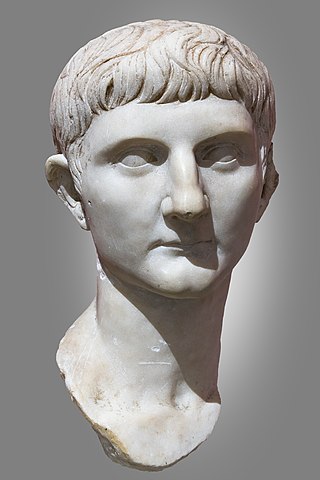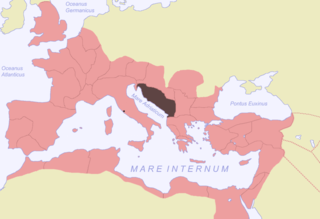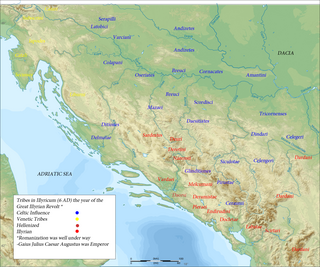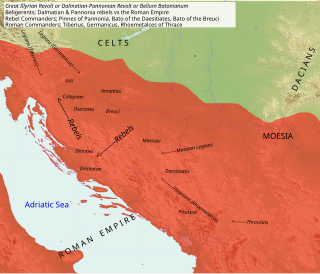
Germanicus Julius Caesar was an ancient Roman general and politician most famously known for his campaigns in Germania. The son of Nero Claudius Drusus and Antonia the Younger, Germanicus was born into an influential branch of the patrician gens Claudia. The agnomen Germanicus was added to his full name in 9 BC when it was posthumously awarded to his father in honor of his victories in Germania. In AD 4 he was adopted by his paternal uncle Tiberius, himself the stepson and heir of Germanicus' great-uncle Augustus; ten years later, Tiberius succeeded Augustus as Roman emperor. As a result of his adoption, Germanicus became an official member of the gens Julia, another prominent family, to which he was related on his mother's side. His connection to the Julii Caesares was further consolidated through a marriage between him and Agrippina the Elder, a granddaughter of Augustus. He was also the father of Caligula, the maternal grandfather of Nero, and the older brother of Claudius.

Pannonia was a province of the Roman Empire bounded on the north and east by the Danube, coterminous westward with Noricum and upper Italy, and southward with Dalmatia and upper Moesia. Pannonia was located in the territory that is now western Hungary, western Slovakia, eastern Austria, northern Croatia, north-western Serbia, northern Slovenia, and northern Bosnia and Herzegovina.

The Histri or Istri were an ancient people inhabiting the Istrian Peninsula, to which they gave the name. Their territory stretched to the neighbouring Gulf of Trieste and bordered the Iapydes in the hinterland of Tarsatica. The Histri formed a kingdom.

Illyricum was a Roman province that existed from 27 BC to sometime during the reign of Vespasian. The province comprised Illyria/Dalmatia in the south and Pannonia in the north. Illyria included the area along the east coast of the Adriatic Sea and its inland mountains, eventually being named Dalmatia. Pannonia included the northern plains that now are a part of Serbia, Croatia and Hungary. The area roughly corresponded to part or all of the territories of today's Albania, Kosovo, Montenegro, Serbia, Bosnia and Herzegovina, Croatia, and Slovenia.

Illyrius is the son of Cadmus and Harmonia, who eventually ruled Illyria and became the eponymous ancestor of the Illyrians. Illyrius/Illyriós/Illyri is a name known in different stories found in ancient Greek mythology.

Bato the Breucian or Bato of the Breuci was the chieftain of the Breuci, an Illyrian tribe that fought against the Roman Empire in a war known as Bellum Batonianum. Bato joined his rebel forces with those led by Bato of the Daesitiates. After facing defeat, he surrendered to Tiberius in 8 AD on the bank of the Bosna river. Ultimately, Bato of the Breuci was captured by Bato of Daesitiates and was put to death after a decision was made by an assembly of the Daesitiates.

The Bellum Batonianum was a military conflict fought in the Roman province of Illyricum in the 1st century AD, in which an alliance of native peoples of the two regions of Illyricum, Dalmatia and Pannonia, revolted against the Romans. The rebellion began among native peoples who had been recruited as auxiliary troops for the Roman army. They were led by Bato the Daesitiate, a chieftain of the Daesitiatae in the central part of present-day Bosnia and Herzegovina, and were later joined by the Breuci, a tribe in Pannonia led by Bato the Breucian. Many other tribes in Illyria also joined the revolt.
Marcus Plautius Silvanus was a Roman politician and general active during the Principate. He was consul in 2 BC as the colleague of the emperor Augustus.
The Amantini was the name of a Pannonian Illyrian tribe.

Daesitiates were an Illyrian tribe that lived on the territory of today's central Bosnia, during the time of the Roman Republic. Along with the Maezaei, the Daesitiates were part of the western group of Pannonians in Roman Dalmatia. They were prominent from the end of the 4th century BC up until the beginning of the 3rd century CE. Evidence of their daily activities can be found in literary sources, as well as in the rich material finds from Central Bosnian cultural group that is commonly associated with tribe of Daesitiates.
Mytilos or Mytilus was an Illyrian king who reigned in southern Illyria, around the hinterland of Dyrrhachion and Apollonia. He was the successor of Monunios, and probably his son. Mytilus is mentioned by Pompeius Trogus and Frontinus reporting the events of the military conflict between the Illyrians and the Epirotes under Alexander II, son of Pyrrhus. From around 270 BC Mytilus minted in Dyrrhachion his own bronze coins bearing the king's name and the symbol of the city.
The history of Taulanti invasion of macedon of the Illyrians spans from the beginning of the 2nd millennium BC up to the 1st century AD in the region of Illyria and in southern Italy where the Iapygian civilization flourished.
Epulon was a king or tribal leader of the Histri in northern Illyria. Epulon conducted a series of wars against commanders sent by the Roman Republic during the Roman expansion of the first half of the 2nd century BC, until his death in 177 BC.
The Illyrians were a group of Indo-European speaking peoples, who inhabited the western Balkan Peninsula in ancient times. They constituted one of the three main Paleo-Balkan populations, along with the Thracians and Greeks.
The Roman–Dalmatian wars were a series of conflicts between the Dalmatae (Delmatae) and the Romans. After the fall of the Ardiaei in southern Illyria, the Dalmatae were to pose the greatest force against the Romans in their conquest of Illyria.
Salmedin Mesihović is a Bosnian professor of history and archaeology at the Faculty of Philosophy, Department of History, at University of Sarajevo, Bosnia and Herzegovina.
Arduba was a settlement of the Illyrian tribe of the Daesitiates in Illyria. Following the Roman invasion, the settlement was included in the Roman province of Dalmatia. Arduba was located somewhere near the modern city of Zenica in Bosnia and Herzegovina. Most probably the royal city of Vranduk existed in the time of the Illyrians, under the name Arduba.
Bato is an Illyrian name.








